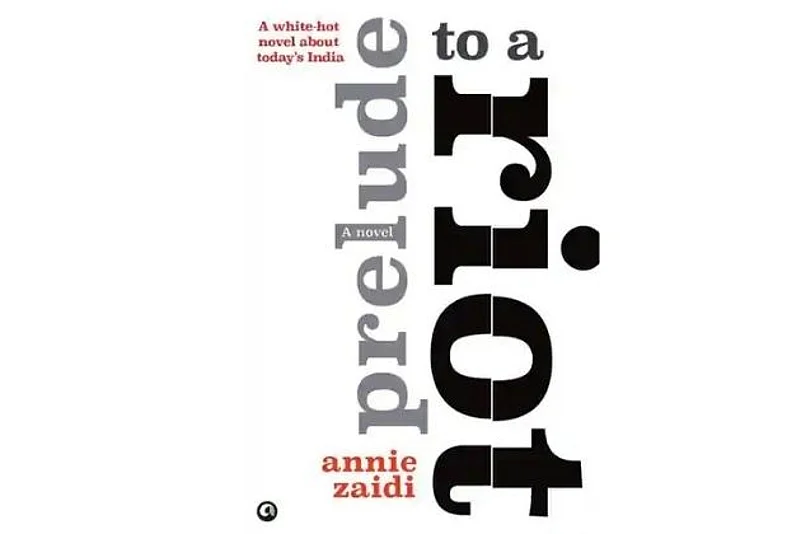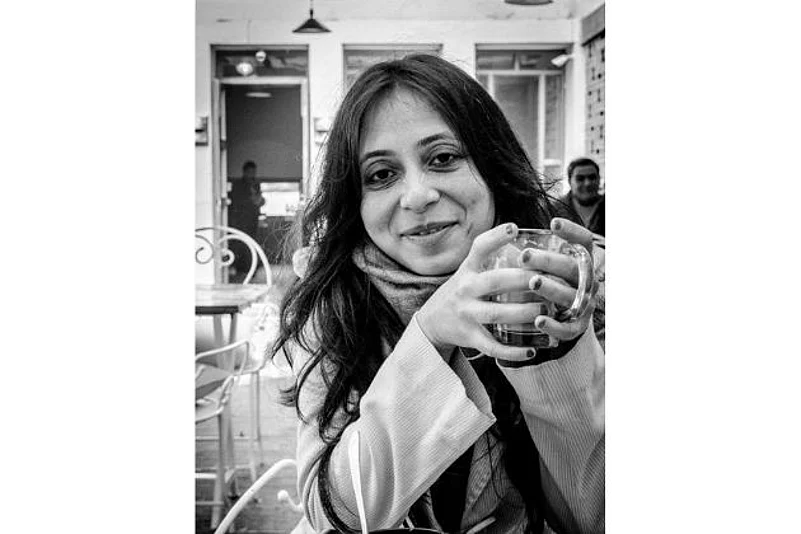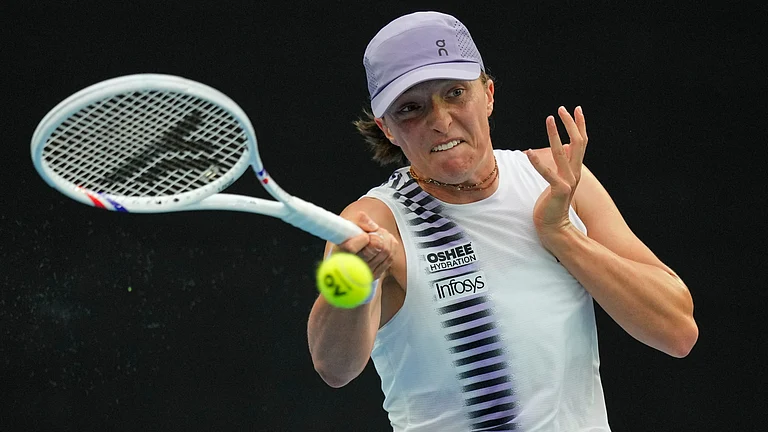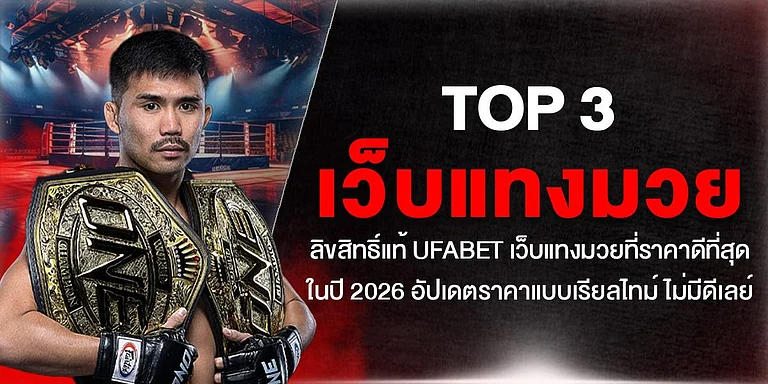A journalist can be an author, an author a translator, a translator a poet, and a poet a filmmaker. Annie Zaidi is all this, and much more.
Based in Mumbai, her latest work Prelude to a Riot won the Fiction Book of the Year 2020 at the Tata Literature Live! Awards. It was also shortlisted for the JCB Prize for Literature this year. Zaidi is the recipient of the Nine Dots Prize for innovative thinking in 2019, for her play ‘Name, Place, Animal, Thing’.

Her craft is guided by a sense of social justice; framing itself around themes of identity, expression, cultural and social prejudice. It flows across diverse forms -- reportage, essays, fiction, drama, poetry, and graphic storytelling. Her publications include Known Turf: Bantering with Bandits and Other True Tales, which was nominated for the Crossword award (non-fiction). She also wrote the novella Gulab and a collection of short fiction, Love Stories # 1 to 14. Zaidi served as the editor of ‘Unbound: 2000 Years of Indian Women’s Writing’. As a playwright, her scripts ‘Jaal’ and ‘So Many Socks’ have been performed in cities, with the latter being nominated for the META awards. ‘Jam’, was the regional (South Asia) winner for the BBC’s International Playwriting Competition 2011. Zaidi has written and directed five fictional short films.
She shares a dalliance with many truths: those of gender, caste, democracy, hegemonic power – which come together in an eclectic mix, probing the politics of belonging. Outlook’s Saumya Kalia catches up with the author about the foresight and insight of Prelude to a Riot, contemporary ideological discourse, culture of protest, and the matrix of art and expression.
Excerpts:

2020 has been a year of dissent, from Shaheen Bagh to farmers’ protests along with new-age resistance movements. Has there been any change -- good or bad -- in how we frame protests in the social discourse?
There has been a change, although the change is not one that occurred over the course of this year. The shift has occurred over the decades. Even though I grew up quite apolitical and rarely read the newspapers as a student, it was very clear to me that a protest was a sign that something was wrong somewhere, and the government (state or centre) was on the mat. They had to respond through reassurance or promises of fixing whatever was broken.
When we saw photographs of the brutal suppression of protests in other countries, it was very clear to us that the state was not behaving in a democratic fashion. In recent years, however, the social discourse has been successfully shifted in favour of ruling regimes; ‘people’ has been conflated with the government of the day, so that protestors may be cast as standing in opposition to the country. Even when governments act in direct contravention of the spirit of their own election manifestos, or when election results show that the vast majority of people are not in favour of a particular party, their policies continue to be framed as being the will of the people and a twisted corollary to that framing is that protestors are against ‘the people’. This casts protesters as an ideological minority, when, in fact, they may well be representing the views of the majority of citizens.
What role does the media play in this? Can the imperative of objectivity continue?
Partly, this is achieved through the fourth estate (TV news in particular, but newspapers and magazines are also complicit) refusing to examine the issue at hand, not investigating independently, and giving inordinate amounts of time and space to government spokespersons. Partly, this is done by confusing the citizenry by focusing on the identity of the protesters instead of the legitimacy of their cause. It could be religion, or political affiliation, or appearance.
When young women were protesting against brutal sexual assault – and who can possibly argue that they are wrong to do? – there was a politician who described them as ‘dented and painted’. When students protest, their smoking or sexual choices were evoked. Editors, journalists, news anchors should be able to cut through the clutter of obfuscatory statements and help to keep the public discourse focused on social rights and wrongs. Sadly, that doesn’t happen very often now.
There are pleas to remove people protesting against the new farm laws, much like those during Shaheen Bagh. What sense do you make of this shared ‘inconvenience’ and collective justice?
Protests are never convenient, and they are most inconvenient for the protestors themselves. Whose lives were most disrupted – those who took a longer route to get to work, or those who stopped work, probably lost income, to focus on the sit-ins? A protest has always been visible, noisy, and a bit inconvenient for others. If life went on as usual, who would notice that anything was amiss in society? People block roads all the time in order to draw attention to a perceived wrong. After road accidents, after rape-murders or custodial deaths. These are individual crimes and yet, a village or a caste group feels that they must do something to force public attention onto a wrong.
Naturally, they are hoping for justice and the more number of people grow aware of an injustice, the likelier it is that the state will respond to help secure justice. The protesters at Shaheen Bagh were no different. They too were hoping for justice, only it was not an individual crime but injustice via state policy. The inconvenience was exacerbated by the state responding as it did: police barricades instead of civilized debate and concern for the rights of minorities and migrants, and the poor who would undoubtedly bear the burden of the new laws.
Once again, I think, this is not so much about the culture of protest as it is about the new media landscape. It would take three days for an honest, non-discriminatory and independent press to communicate these facts about Shaheen Bagh, or any other long-running protest. That they choose not to do so is revelatory.
Any depiction of interfaith relationships -- real or fictive -- has come under a sharp attack. How do you understand the discourse around ‘love jihad’? What is the outrage against?
I have a chapter called ‘Mixed Blood’ in 'Bread, Cement, Cactus'. I had been wanting to write about how the Love Jihad discourse ties up with other kinds of misogyny in our society, its historic roots and contemporary manifestations, and how legislators in free India have indirectly subverted our (women’s) claims to equality. For instance, Rajkumari Amrit Kaur had argued for the right to consent (in the context of marriage) to be included explicitly in the Constitution. However, the majority of the drafting committee did not agree with her. I wish she had prevailed because then, right at the outset of India’s tryst with itself as a modern republic, people would have felt freer to choose who to marry. It would have sent out a clear signal – marriage is an individual business, and clans and religious groups should back off. Even now, it is not too late. The Special Marriage Act should be amended. Everyone should be able to marry at a moment’s notice, without giving any explanations or warnings. Divorce should also be much simpler. Nobody should be able to force someone to stay in an unhappy marriage. Women’s and children’s (and men’s) rights are served far better if the state focuses instead on social security, minimum wage, guaranteed employment, free education and universal healthcare.
On winning the Tata Live book prize, you wrote about sponsored literary festivals and the motivation of the rich and powerful to get speakers to participate. For any society to remain sane, a little truth must survive, was your hypothesis. Can you explain what you mean by that?
The question of who sponsors art, and what art achieves in any society, has been troubling me for a long time. The vision of artists and their sponsors is often at variance. How does this relationship work, then? Artists are dependent on others, not just for their income, but also for spaces (physical, digital, metaphorical) wherein they engage with their audience. Picasso can make Guernica, but where will it hang? Will it survive if the powerful decide to get rid of it? Some of the greatest Renaissance art in Italy was commissioned by patrons like the Medici family, bankers and businessmen. Why did they bother? We have had stories told down the ages about kings and queens, their infidelities, filicides and parricides. Books, plays, oral storytelling arts were supported by the nobility or very wealthy merchants for most of our history. Why did they not insist on censoring all stories so that the nobility was only cast in benevolent light?
This might be for multiple reasons. One, truth itself is powerful. Those who wish to remain powerful must retain an acquaintance with the truth. They may serve disinformation to the rest of the country, but they themselves must have access to correct information. They may not invest in mass access to the arts, but they themselves must have access to the vision, the beauty and even terrifying clarity that artists bring. Two, lack of truth is associated with breakdowns of all kinds. What do we recognize as a loss of sanity? It is a state in which you can no longer tell what is real and what isn’t, what is harmless and what isn’t. Individuals who lose touch with the truth react in unpredictable ways. A society cut off from the truth, and from truthful art, starts to lose itself in similar ways. It becomes unpredictable and does not necessarily act in self-interest, much less underwrites someone else’s profit. Alternately, the truth goes underground, leaving the powerful in the dark and, this is worse for them. Look at any society where truth and art have been suppressed, and you will see that it is a sick/sickening society or a nation at war. I don’t think this state of affairs suits too many people, not for too long anyway.
In one of his books, Milan Kundera wrote how extreme grief may ultimately vent itself in violence. Sometimes, it takes the form of apathy. Do you agree with that? What did you find on examining the roots of religious intolerance?
Yes, I agree. Grief and shame are often at the root of anger and apathy. I cannot comment on all forms of religious intolerance but one thing I feel quite strongly is that all social behaviour is cultivated. Intolerance is not spontaneous and it is not natural. You leave kids alone and they don’t recognize race or religious difference. You teach kids intolerance through your own words and actions. Adults take their cues from leaders, both at the local community level, and from the broader political and religious leadership. If extremists and fundamentalists are rewarded by politicians, if threats or acts of violence are not punished, then people learn to grow more intolerant.
Soliloquies in 'Prelude' are based on research about a non-fiction article about labour rights on plantations. Do you think facts, when dressed as fiction, are easier to digest? In other words, if 'Prelude' were told as a non-fiction narrative, would it have a similar effect?
Non-fiction achieves different things and it plays by different rules. I don’t think I could have written Prelude to a Riot as non-fiction. Those conversations were often overheard and even when they were on the record, the things that were being said were said with a degree of confidence that came from privilege. In order to describe that privilege in non-fiction terms, I would have had to unravel several spools of history, economics and anthropology. Even if I could pull that off, I could not have juxtaposed these conversations to make it appear that the protagonists know each other well. In fiction, it is possible to capture the emotional drama of what actually occurs without needing people to confess to it.
There are musings on displacement and identity, of 'home' and what it means to belong as a minority or a migrant in your work. What sense did you make of something like the citizenship act or the Jammu & Kashmir's Forest Act?
It is difficult to answer this in brief. I have written a whole book just trying to answer that question.
Were you able to find the answer? Or reach closer to it?
There isn’t any singular answer, but I did come to a more nuanced understanding of both, belonging and citizenship. While we understand that our self-identification with a particular region, village or city, is flexible because many of us do move around the country, citizenship is something we take for granted. We don’t have any control over it since it is decided at birth, and for the vast majority, there is no way of changing it. For those reasons, citizenship is also one of those things that should not be challenged. It should never have to be proven.
Does literature, or art, carry an imperative of bringing about change? Did you expect a change?
I can only hope that it does.
Garuda, the teacher, in your book says at the very start: “Everything is tolerated. What we do not tolerate is movement. Social mobility.” This seems to be an adage that holds true for gender, caste, class, religious violence in India, even the world. How can we break from this cycle of intolerance?
Through lots and lots of inter-caste and inter-faith marriages, and more nuanced anti-discrimination laws. Housing discrimination is rampant in India which leads to the creation of ghettos, which leads to the entrenchment of prejudice.
The novel ends before violence erupts. If given a chance, would you revisit and describe the riot or its aftermath? Or is it best left to the wild realm of imagination?
No, I don’t like to visit violence. It doesn’t even have to be imagined. There’s so much of it, and so awfully visible now that we have cameras everywhere.
Does the abundant coverage of violence feed into a sense of social apathy? Do we inevitably care less if we know/see more?
Not apathy, perhaps, but a certain social paralysis. From my own experience, I can say that being aware of too much violence, too many wrongs, does not diminish my ability to feel anger or sympathy but it does lead to a sense of listlessness, and the feeling that one is powerless against the forces that perpetuate violence.
Talking about identity and expression three years ago, you said in an interview, “We are who we think we are, depending on what story has been told to us.” What story is being told to people today, in terms of our collective identity?
We are being sold a story where is no ‘collective’ identity. A collective is made up of the many, right? In this story, a single identity is defined by dominant, socially hegemonic groups and others accept it as the norm, even if their life circumstances do not endorse that way of life, and even though everything in our lived and historic experience tells us that narrow and exclusionary attitudes are unviable.






.jpg?w=801&auto=format%2Ccompress&fit=max&format=webp&dpr=1.0)














.jpg?w=200&auto=format%2Ccompress&fit=max)



